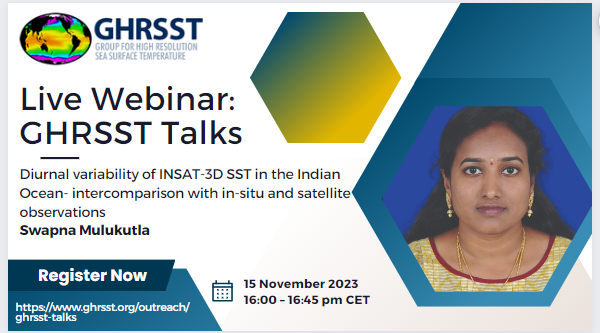Wednesday, 15 November 2023
We start this GHRSST Talk at
16:00 pm – 16:45 pm CET
From 14:00 pm – 14:45 pm UTC
(check your timezone https://www.worldtimebuddy.com)
Diurnal variability of INSAT-3D SST in the Indian Ocean- intercomparison with in-situ and satellite observations
Authors: Swapna M, Rajesh Sikhakolli, Nayak R.K, Rajashree V Bothale.
(1) Ocean Science Group, Earth and Climate Sciences Area, National Remote Sensing Centre, ISRO, Hyderabad, 500037. swapna_m@nrsc.gov.in, swapna.geophysics@gmail.com
(2) Ocean Science Group, Earth and Climate Sciences Area, National Remote Sensing Centre, ISRO, Hyderabad, 500037. rajesh_s@nrsc.gov.in.
(3) Earth and Climate Sciences Area, National Remote Sensing Centre, ISRO, Hyderabad, 500037. rabindrakumar_nayak@nrsc.gov.in.
(4) Earth and Climate Sciences Area, National Remote Sensing Centre, ISRO, Hyderabad, 500037. rajashree_vb@nrsc.gov.in
Abstract
Sea Surface Temperature (SST) is an Essential Climate Variable used in oceanographic and meteorological application studies such as air-sea interaction, ocean mixing, boundary layer processes and ocean state forecast, which require high temporal resolution SST. Indian Geostationary Satellite INSAT-3D imager has been designed to provide 30 minute SST for the tropical Indian Ocean with frequent sampling. In order to ascertain about the quality and usability of INSAT-3D SST products for various oceanographic studies its evaluation is essential to best access the accuracy of the retrieved SST product. In this regard, latest version (V02) of INSAT-3D SST data from May 2021 to December 2022 has been considered along with In-situ buoys SST data obtained from Indian Moored Buoy network available at 1m depth for intercomparison. Contemporary MODIS SST is also used for the same period to understand the spatiotemporal variation in SST product accuracy in the Indian Ocean region. The intercomparison of INSAT-3D SST is performed against in-situ and MODIS SST observations using standard statistical parameters such as Mean, Bias, Standard Deviation, correlation coefficient (r), and Root Mean Square Error. We attempted to study the diurnal variability of SST over Indian Ocean region, as the Indian Ocean is noted as one of the hot-spot region and significantly contributes for the global ocean warming. Accordingly, we present results about the diurnal variability captured by INSAT-3D, its comparison with buoy measured diurnal variability, and the role of skin versus bulk SST differences in the observed diurnal variability will be discussed.
About our speaker
Dr. M. Swapna did her Master of Science and PhD in Geophysics from Osmania University, Hyderabad, India. Her PhD thesis is ‘Tsunami Modelling and Sensitivity Analysis Studies over ridges in the Indian Ocean’. She joined in National Remote Sensing Centre(NRSC), ISRO Hyderabad as a Scientist in 2015. She is working in the Physical Oceanography Division of NRSC. She worked on thermal front mapping using MODIS and GHRSST and understanding their dynamics over Indian coastal water using MODIS and GHRSST SST products. She has also assessed the ISRO’s INSAT-3D SST in comparison with in-situ bouy SST and MODIS SST observations over the North Indian Ocean. She is also working on SAR Ocean applications like oil spill pollution studies, oil spill trajectory modelling, ship detection, and ocean rain cells over oceans.
Download the presentation in PDF
https://zenodo.org/records/10227224
Videorecording
For registering

